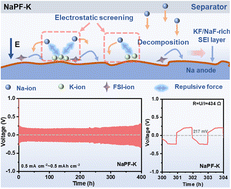Salt engineering toward stable cation migration of Na metal anodes†
Abstract
Na metal batteries (NMBs) have received extensive attention due to their high theoretical capacity and low electrochemical redox potential. However, dendrite growth and an unstable solid electrolyte interphase (SEI) layer in Na anodes limit the development of NMBs. In this work, we attempt to introduce potassium bis(fluorosulfonyl)imide (KFSI) as an NMB salt additive in electrolyte and find that this KFSI-containing electrolyte can enable highly reversible and nondendritic plating–stripping of Na metal anodes. Excellent cycling stability for 400 h at 0.5 mA cm−2 in a Na‖Na symmetric cell and a high coulombic efficiency of 97.7% after 200 cycles in a Na‖carbon cloth (CC) asymmetric cell can be achieved in KFSI containing electrolyte. From our results, we find that K-ions from KFSI can show electrostatic shielding on the tip of the dendrite and then guide the uniform deposition of Na ions due to the lower potential of the K/K+ couple (−2.93 V vs. the standard hydrogen electrode (SHE)) compared with that of the Na/Na+ couple (−2.71 V vs. SHE). In addition, the S–F bond cleavage from the FSI anion presents low dissociation energy of S–F from density functional theory calculation, contributing to the formation of a stable fluoride (NaF and KF) rich solid electrolyte interfacial layer on the Na anode surface, which is also in favor of a tough Na plating–stripping process. We believe our findings will guide salt engineering to enhance the electrochemical performance of the Na metal anode.

- This article is part of the themed collection: Journal of Materials Chemistry A HOT Papers


 Please wait while we load your content...
Please wait while we load your content...